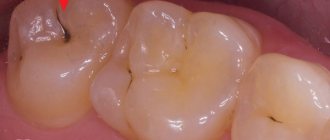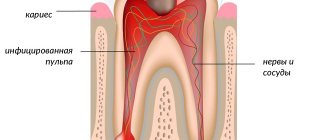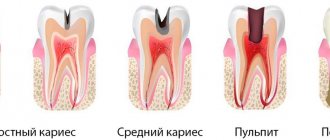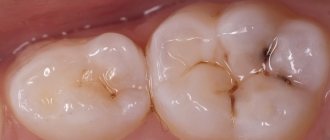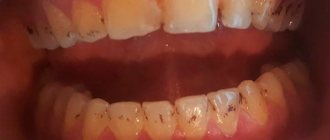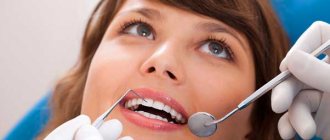Myth: Braces cause tooth decay.
Of course, braces themselves do not cause caries. But they can create conditions for its development.
The main problem is the impossibility of complete oral hygiene, since braces are a complex system with many small elements and micro-gaps. Even using brushes or an irrigator, regular brushing of teeth and following a special diet does not guarantee one hundred percent removal of plaque. As a result, caries under braces develops very quickly, especially in places that are difficult to reach with a toothbrush.
Braces also complicate the process of self-cleaning of the oral cavity, which is why caries progresses quickly. Therefore, it is necessary to treat caries with braces immediately after it is identified, without waiting for the end of orthodontic treatment when the braces are removed.
Prices for installing braces
| Name | Price |
| Ceramic braces | 40,000 rub. |
| Metal braces | 25,000 rub. |
| Lingual brace system “Incognito” | 300,000 rub. |
| Observation (one visit) | 500 rub. |
| Treatment of dental anomalies (Invisioline) | from 20,000 rub. |
| Treatment of dental anomalies of the 1st degree of complexity | 25,000 rub. |
| Treatment of dental anomalies of the 2nd degree of complexity | 50,000 rub. |
| Treatment of dental anomalies of the 3rd degree of complexity | 75,000 rub. |
| Treatment of dental anomalies of the 4th degree of complexity | 100,000 rub. |
Caries during treatment with aligners
From the point of view of preventing and treating caries, mouthguards are more convenient than braces.
Oral hygiene with aligners is effective and simple: you remove the aligners, brush your teeth as usual, rinse the aligners themselves and put them back on. While braces retain food debris, aligners do not in any way prevent the teeth from being thoroughly cleaned. Accordingly, the risk of developing caries is less than with treatment with braces.
If caries does occur, treating teeth with aligners is also much more convenient. We said above that caries can be treated with braces, but sometimes you have to peel off the bracket or remove the arch. The aligners are simply removed, and the doctor gets full access to the teeth.
Pain from cold
Increased sensitivity of enamel to irritants is called hyperesthesia. Toothache in adolescents, as a manifestation of hyperesthesia in response to temperature exposure, develops due to easier transmission of impulses to the pulp, the sensitive part of the tooth, which contains nerve fibers. This happens as a result of numerous processes leading to a decrease in the protective properties of enamel. This can be caries and non-carious lesions of tooth tissue.
The second reason for pain from cold and hot is the exposure of the neck and root of the tooth when the gums sag. In the root area, the layer of enamel is much thinner than in the coronal part. Dystrophic processes in periodontal tissues quickly lead to the destruction of the periodontal junction and exposure of sensitive areas of the teeth.
Where to treat caries with braces or aligners
We will not examine the question of how to treat caries under braces or with aligners: the technique remains at the discretion of the specialist and is unlikely to be useful to the patient. But the choice of clinic and doctor depends on you. The fact is that caries treatment must be carried out without compromising orthodontic treatment, that is, the therapist must not only eliminate the disease, but also understand how to adjust the anatomy of the tooth to the anatomy of aligners or braces. Such knowledge is usually correlated with the dentist's experience. Our clinic specializes in correcting bites, so the entire team, including therapists, have experience working with the dental system during orthodontic treatment.
Need some advice?
Enter your phone number and we will give you a free consultation on your problem
Make an appointment
*By making an appointment you consent to the processing of your data
How is caries treated under braces?
If, while wearing braces, it turns out that caries has appeared on your teeth, be it a white spot or a cavity, your dentist will recommend treating it as soon as possible. It is important to understand that braces are not a contraindication to caries treatment.
If the arch does not block access to the affected area, then you won’t even have to remove the system to treat the tooth. But if a lesion is found under the brace or in a hard-to-reach area, the structure will have to be removed. Sometimes it is enough to remove only one bracket. It all depends on the location of the caries and the scale of the lesion. After the treatment is completed, the orthodontist will reinstall the device for the patient.
Otherwise, caries while wearing braces is treated in the same way as without them. First, the stage of the disease is determined, and then the optimal method is selected. If the pathology is at an early stage and there is no cavity in the tooth, the dentist can perform remineralization therapy and deep fluoridation. With these methods, teeth are coated with special compounds that contain calcium, phosphorus and fluorides. These mineral substances strengthen the surface of tooth enamel, make it less sensitive, restore its normal structure, and prevent cariogenic bacteria from penetrating deep into the tooth.
Another option for minimally invasive caries treatment is the ICON infiltration method. It seals the pores of tooth enamel and prevents caries from penetrating deeper. All these methods are effective only at the stain stage. If the process is deeper and there is already a cavity in the enamel or dentin of the tooth, then caries is treated with preparation and filling.
Prevention of caries
Some tips on how to avoid caries under braces or when treated with aligners:
- brush your teeth after eating, use oral hygiene products recommended by your doctor;
- When treating with braces, follow a diet: avoid sticky, fibrous, adhesive foods that can get stuck between the teeth and braces and cause the development of caries;
- use toothpaste and mouthwash with remineralizing properties (in consultation with your doctor);
- If the enamel darkens or plaque forms, undergo professional cleaning (in consultation with your doctor);
- do not miss scheduled visits to the orthodontist: they are needed not only to monitor the progress of orthodontic treatment, but also for the timely detection of problems with teeth and gums;
- After removing braces, some patients are prescribed a course of enamel remineralization to strengthen the enamel and prevent the occurrence of caries.
Following these recommendations will reduce the risk of caries when treated with braces or aligners. You can find out which bite correction method - braces or mouth guards - is right for you during a consultation at our clinic. Sign up now!
Doctors' opinion
On various forums you can find many reviews that the installation of braces negatively affects the condition of the enamel, provoking the development of caries and triggering the process of leaching of useful microelements and mineral salts from the protective layer of teeth - demineralization of the enamel and destruction of its organic matrix. This pathological process is complex and leads to rotting of the hard tissues of the tooth.
This information is partly correct. But experts are unanimous in the opinion that such a clinical picture is caused in most cases by the human factor.
The initial degree of development of caries from wearing braces is excluded for two reasons:
|
Remarkable!
The hardest layer of the crown of the tooth under the clasp is tightly closed from the penetration of pathogenic microorganisms. Thus, it becomes clear that the enamel can be destroyed not under the bracket, but around it.
When to start treatment?
Treatment of caries should be carried out as timely as possible, both without braces and with them. This is the only chance to preserve the integrity of the affected tooth and the health of the rest.
The treatment procedure for a fixed orthodontic system differs little from the standard therapeutic one. The only difference is in the number of doctors involved in the procedure, as well as in the preparatory manipulations.
To stop caries, the therapeutic process first involves an orthodontist, who removes the arch and, if necessary, peels off the bracket, and then the dentist-therapist gets to work.
At the same time, orthodontic services are usually provided free of charge. In some clinics, orthodontists have sufficient practice to carry out treatment independently, without the involvement of a therapist.
The need to remove structural elements will depend on the location of the pathological focus . In some situations, it is possible to carry out therapeutic manipulations without any preliminary preparation of the field of activity, i.e. without removing the arch.
Removal of the system bracket is necessary only if the cariogenic zone is localized near the bracket or under it.
Removal of the arch may be necessary if the destruction began on the lateral surface of the teeth. It is possible to avoid removing the corrective arch only if the teeth are in the initial stage of movement, during which a wide interdental space is formed between them.
Thanks to this, the dentist can easily prepare the affected surface, without affecting the system and adjacent teeth.
Even if some elements have been removed, the treatment always ends with their re-fixation in exact accordance with the initial position.
Diagnosis of the disease
Cervical caries can be diagnosed during a dental examination of the oral cavity. The specific location and rough structure of the carious spot make it possible to differentiate the pathology from a wedge-shaped defect and simple caries.
Additionally, instrumental diagnostic methods are used: dental radiography, radiovisiography, transillumination and others. They allow you to assess the degree of penetration of caries into the tooth cavity, see hidden lesions and predict the effectiveness of treatment.
Symptoms and manifestations
Most often, caries develops in places where bacterial plaque accumulates, that is, in the area where the brackets fit into the enamel surface, as well as at the neck of the tooth.
Damage can be determined by the following manifestations:
- a chalky or yellow spot appears on the enamel , indicating the beginning of the process of demineralization of dental tissues;
- Over time , the stain darkens, becoming brown . It has a smooth shiny surface. There are no visible signs of tooth decay;
- at the site of pigmentation, the enamel becomes painful , reacting to thermal and chemical irritants;
- in the absence of therapeutic intervention by the dentist, a visible defect in the form of a depression forms , formed as a result of the destruction of the surface layer of enamel.
If, after the destruction of a section of enamel, you do not seek help from a dentist, then caries will lead to dentin deformation and can damage the pulp.
Why do you need to have your braces cleaned at the dentist?
Even if you follow all the rules and recommendations listed above, you must visit the dentist at least once every 3-6 months. This should be done because caring for teeth with braces at home, no matter how thorough they are, will not protect a person from the appearance of plaque and tartar.
Complete cleaning is only possible under appropriate conditions: ultraviolet rays and special equipment. Moreover, only 10-15% of patients fully comply with all doctor’s instructions, so professional cleaning becomes a reliable and effective means of preventing the occurrence of dental diseases.
Frequent visits to the doctor are not required unless there is severe pain or discomfort. Therefore, by following all the recommendations, you can achieve good results and ensure the proper level of oral hygiene. And to consolidate the effect, it is worth having a professional cleaning to be sure of the health of your teeth.
